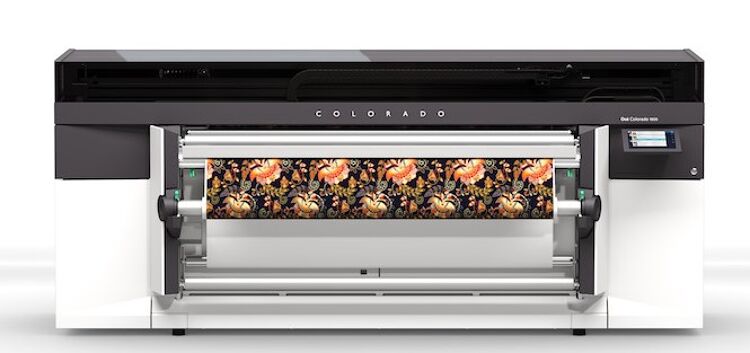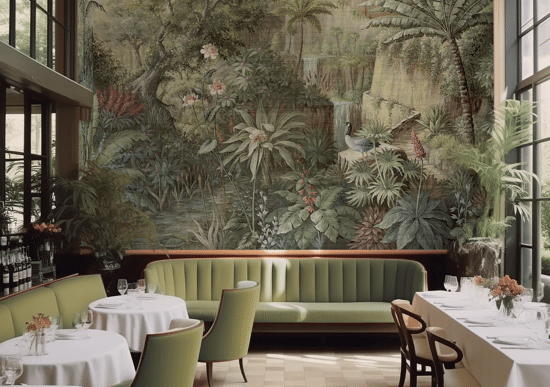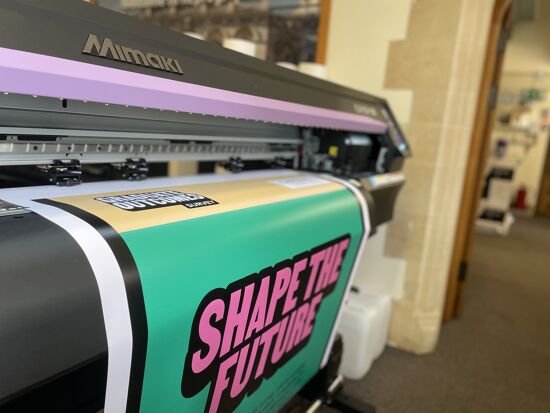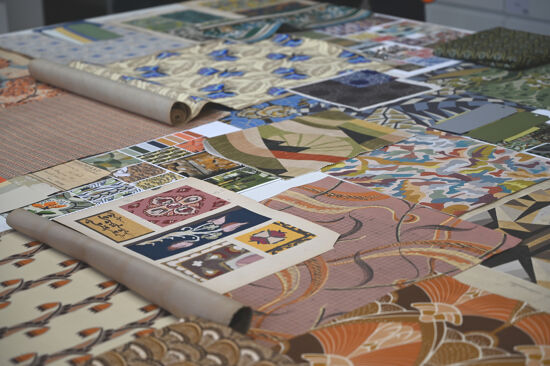Opportunities in wall coverings for wide format printers

Nessan Cleary discusses the increasing interest in digitally printed interior decor and the current opportunities for wide format printers regarding wall coverings. Nessan also shares the different technologies that can be used to form the foundation for a dedicated service offering.
There’s a growing interest in digitally printed interior decor, highlighted by the Printeriors feature at Fespa shows. Wallpapers and wall coverings are a major part of this, within both the commercial and consumer markets. This can include everything from company logos and semi-permanent marketing messages through to graphics to cheer up public spaces such as hospital waiting rooms, or decoration for a child’s bedroom. There is some leeway in exactly how we might define a wall covering, meaning that there’s plenty of room for most large format service providers to offer something in this area.
This could include pictures printed on textile or canvas, combined with a frame or some form of mounting, which most wide format printers should be able to produce. Dye sublimation should produce the best results for textiles, particularly for home decor use, as these prints will have a pleasant feel, with no odours. Better still, these prints can be treated for flame retardance and will also be washable, which are useful factors for home use.
In terms of wallpapers, HP’s Latex printers have proven to be quite popular amongst wallpaper suppliers, where they are mainly used to satisfy custom wallpaper demands. The water-based inks are seen as environmentally-friendly and lack the odour associated with UV-curable prints. It’s also easier to wipe latex prints clean rather than fabric.
In recent years a number of other suppliers have also started offering latex printers. It’s worth noting that the inks do not actually contain latex and are a form of resin ink, with some vendors choosing to brand their offerings as resin rather than latex though there’s little practical difference between these. Thus Epson, Roland, Ricoh and Brother all offer either latex or resin printers and are also targeting the wallpaper market.
Fujifilm has just introduced an alternative to latex/ resin inks, which it calls AquaFuze. This is a hybrid ink that combines water with UV-curable latex elements. The basis behind the AquaFuze ink is the emulsion dispersion technology that Fujifilm originally developed for the photo industry and which ensures that all the different elements remain in suspension relative to each other. The accompanying 1.6m wide rollfed printer, which has been developed by Mutoh, is fitted with both a UV LED array and a heater with an air knife to direct the heat. This heat causes the latex to melt, which forms a membrane and holds the pigment to the substrate while the LED lamp then reacts with the UV elements, causing that membrane to solidify and bond with the substrate. There’s no need for any primer or optimiser and the inks will work with most common wide format materials.
 This Mutoh Hydraton 1642 uses Fujifilm AquaFuze inks. ©Nessan Cleary
This Mutoh Hydraton 1642 uses Fujifilm AquaFuze inks. ©Nessan Cleary
The ink cures to a very thin film, which means that it’s not suitable for producing textured effects, but does allow the look and feel of the underlying substrate to come through. The main target markets are sign and display, plus wallpaper and interior decoration
Canon has found considerable success in the wallpaper market with its Colorado series of large format roll to roll printers. To capitalise on this, Canon has introduced a Wallpaper Factory configuration. This includes an inline cutter and jumbo roll so that it can be left to run overnight. There’s also a Print Factory configuration that includes a Fotoba cutter inline.
The Colorado printers use a unique UVgel ink, which is supplied as a gel, but heated in the printheads to 65ºC until it turns to a liquid that can be jetted. once the ink hits the much cooler substrate it returns back to its gel state. Initially, the ink is pinned before a final cure from the LED lamp, which is mounted to a separate carriage so that it is independent of the printheads. This approach means that it will print to a wide range of substrates, without requiring any pre-treatment, and without the risk of any dot gain. The Colorados print in CMYK with an optional white for the latest M-series. The print width is 1625mm.
The Lithuanian company, UAB Dimense has developed a way to produce highly textured prints, which relies on a combination of media, ink and printer working together. UAB Dimense is a subsidiary of UAB Veika, which itself makes materials for wallpaper. Roland DG has been reselling the Dimense printers since 2022 and recently acquired a 50.1 percent majority of the shares of UAB Dimense.
The heart of the Dimense process is the special media that has a patented EcoDeco layer on top of a non-woven base. This works with a transparent ink, that the company calls Dimense structural ink, which is applied in the areas that are meant to remain flat.
The final part of the jigsaw is the Dimensor-S printer, which is a roll to roll machine with two piezo inkjet printheads. This uses water-based latex inks to print coloured images, as well as the structured ink to define the non-textured areas. Heating within the printer causes the EcoDeco top layer on the media to foam and expand by up to 1.5mm in the areas where the ink has not been applied. The printer can be used to print either just the structural ink, to create the textured patterns, or to print the patterns alongside the CMYK colours.
The printer has a 1.6m print width and can run at up to 30sqm/hr
The Dimense media is available in a number of different finishes such as matte, pearlescent, gold and silver as well as one designed to give a deeper embossing effect.
The entire system is said to be environmentally-friendly, with no PVC, phthalates or other undesirable chemicals used. As well as wallpaper, it can also be used to reproduce oil paintings complete with textured brush strokes, as well as point of sale advertising.
Xeikon will not be a familiar name in the large format market since it mainly makes roll-fed dry toner commercial presses and inkjet label printers though it has exhibited at Fespa shows before. Xeikon does offer a specific wallpaper solution based on an inline converting unit that takes the roll-fed prints coming out of its presses, varnishes and slits them before winding them onto a standard wallpaper roll. This is matched with a dry toner commercial press, which has a 508mm print width that’s slightly narrower than the usual 530mm of conventional wallpaper. Xeikon has also worked with Felix Schoeller, which has developed wallpapers specifically for use with the Xeikon presses.
 Xeikon has created a wallpaper printing solution by adding an inline converting unit to an existing dry toner press. ©Nessan Cleary
Xeikon has created a wallpaper printing solution by adding an inline converting unit to an existing dry toner press. ©Nessan Cleary
Finally, the German company Wallpen has taken a completely different approach. It has developed a mobile, large format UV printer that can print graphics direct to walls and vertical surfaces, up to almost four metres high. It’s mainly targeted at shopping malls and hospitals as well as creating displays on museum or office corridor walls.
In conclusion, there’s plenty of scope for most wide format service providers to produce wall coverings and a good choice of technologies that could form the basis of a dedicated service offering.
Topics
Recent news

Industry Insights, Design Trends and Disruptive Innovations for Interior Decoration
Debbie McKeegan shares key trends and innovations in the interior decoration industry taking place and demonstrated at recent European exhibitions in Germany and France. The interior decoration industry is adapting to challenges like overstock and supply chain disruptions by integrating digital and traditional methods, aiming for more agile and environmentally friendly solutions.

Bridging Design and Technology: The Story of Western Sensibility an interview with Kathryn Sanders
In this podcast episode, Debbie McKeegan interviews Kathryn Sanders, the CEO & founder of Western Sensibility, a US based company that merges interior design with digital printing technology. They discuss the origins of the business, its innovative services, and the importance of sustainability in the textile industry.

How to choose the right machine for indoor print
With interior print one of the stand-out growth areas of the industry in recent years, it is crucial printing companies select the right equipment to achieve the best quality results. Here, Rob Fletcher picks out some of the machines best suited to this work.

Resilience, Innovation and Heritage: The 100-Year Journey of the Standfast & Barracks
Renowned textile printing facility, Standfast & Barracks celebrates 100 years who are known for their expertise in rotary, flatbed and digital printing techniques. Debbie McKeegan looks at the history of the company and speaks to Lisa Montague, Managing Director about how they have adapted over the years and their future plans.